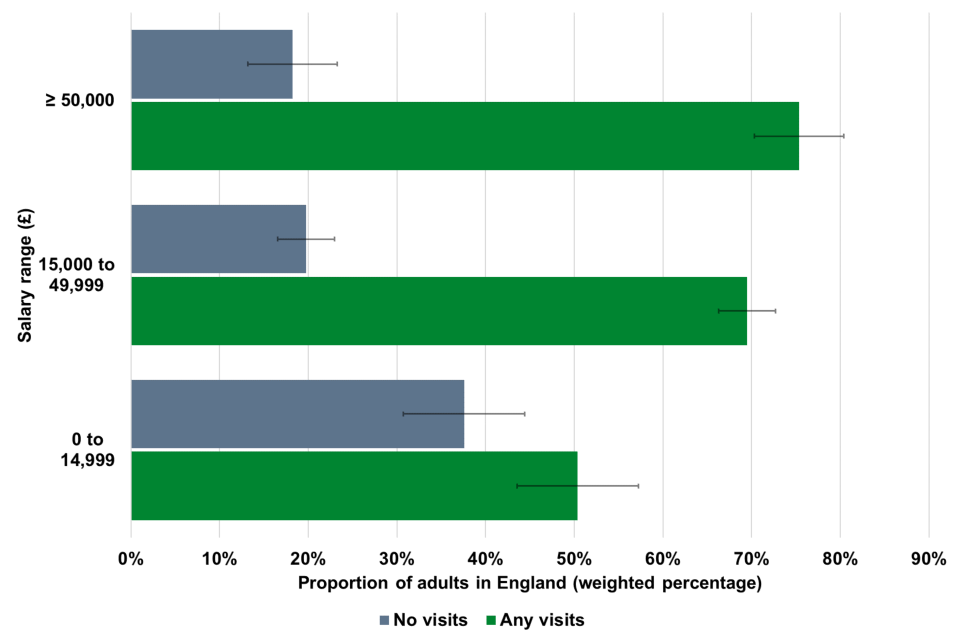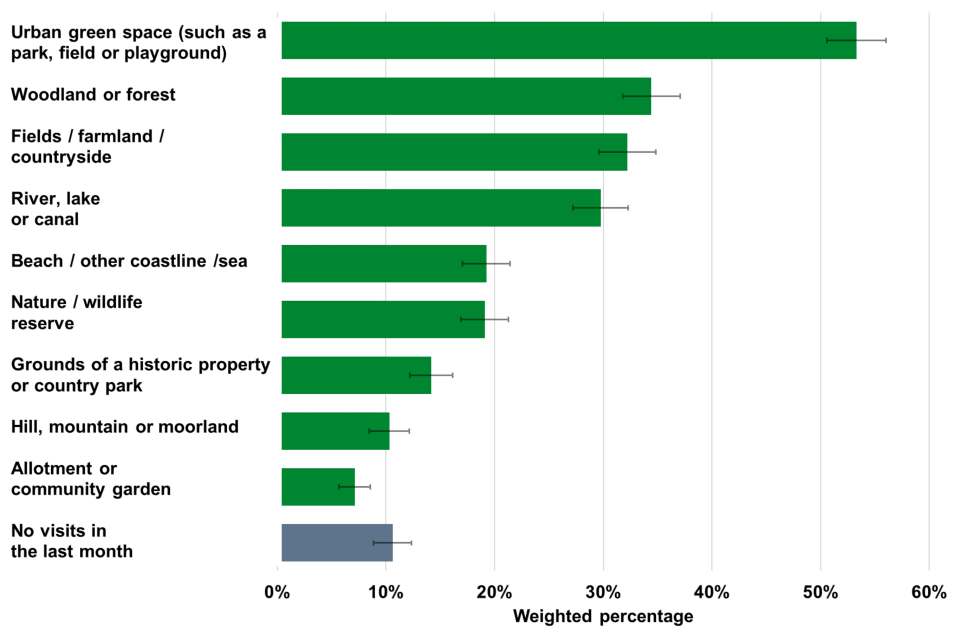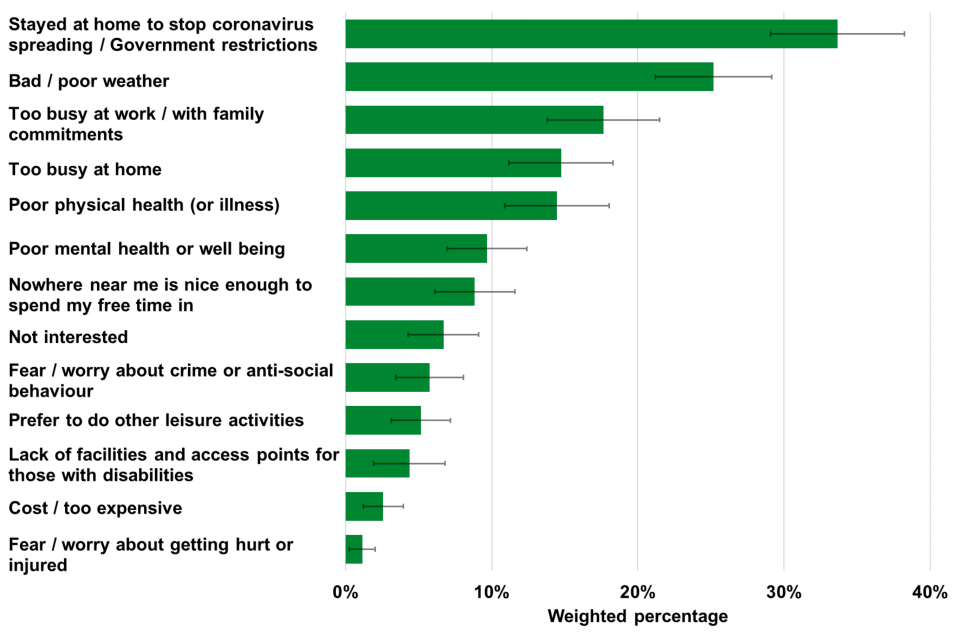The People and Nature Survey for England: Monthly interim indicators for April 2021
Updated 17 November 2023
Applies to England
1. Main Findings
- In April, national lockdown restrictions continued to be lifted in England and 68% of adults had visited a green and natural space in the last 14 days.
- A total of 391,548,094 visits were made to green and natural spaces in April.
- Twenty two per cent of adults had not visited a green and natural space in the last 14 days.
- The likelihood of visiting a green and natural space and the total number of visits made differed by household income and age group.
- Of those earning more than £50,000, 75% reported a visit to a green and natural space. This is compared to 50% of those earning less than £15,000. Adults earning more than £50,000 also took three times as many visits as those earning less that £15,000.
- Thirty three per cent of adults aged 65+ had not made a visit to a green and natural space compared to 15% of 16-24 year olds. However, in terms of total number of visits, adults aged 65+ had taken twice as many (92,287,544) in comparison to 16-24 year olds (45,805,861).
- The main reasons for not spending time outdoors in the last 14 days were ‘Stayed at home to stop coronavirus spreading / Government restrictions’ (34%) and ‘Bad / poor weather’ (25%). ‘Too busy at work / with family commitments’ was the third most reported reason (18%).
- Forty five per cent of adults said visiting green and natural spaces has been even more important to their wellbeing since coronavirus restrictions began.
2. Other pages in this release
The People and Nature Survey for England, led by Natural England, is one of the main sources of data and statistics on how people experience and think about the environment. It began collecting data via an online panel (adults aged 16 years and older) in April 2020, and runs continuously, in line with Government Statistical Service guidance on data collection during the COVID-19 pandemic.
The official statistics in this publication are based on a survey of 2,086 adult respondents conducted online continuously between 1st - 30th April 2021 (inclusive). Throughout this bulletin, “this month” and “April” refers to this period.
A spreadsheet containing all the results for April has been published alongside this report. Previous indicator reports for Year 1 of the survey (April 2020 - March 2021), can also be viewed.
Further information about the People and Nature Survey for England (including information on methods, strengths and limitations, and Official Statistics status) is available. To receive updates on the survey, including data releases and publications, sign-up via the People and Nature User Hub.
Results from this survey for April covered a period of national easing of lockdown restrictions in England. This page summarises the latest advice on accessing green spaces safely.
3. Official Statistics
Initial releases from the People and Nature Survey that used an interim weighting method were released as Experimental Statistics. This status highlighted to users that these Official Statistics were in the National Statistics testing phase and that Natural England was still working on further developing the methodologies used in their production whilst ensuring adherence to the Code of Practice for Statistics (the Code).
After one year of data collection, we have refined data quality assurances to capture additional metrics on data quality and finalised an optimal and bespoke weighting method for the People and Nature Survey. As such, releases from the People and Nature Survey that use the bespoke weighting method (as opposed to the interim weighing method) are no longer designated as ‘Experimental’ (a subset of Official Statistics) and are instead designated as Official Statistics. For further justifications behind this change, please see our brief statement here.
4. Time spent in green and natural spaces
Figure 1 shows the proportion of adults in England who had taken a visit to a green and natural space during the previous fortnight, grouped by age range.
Sixty eight per cent of adults in England said that they had spent time outside in green and natural spaces in the previous 14 days. Twenty two per cent said they didn’t make a visit, but this figure varied between demographic groups.
Of those aged 65+, 33% did not make a visit to a green and natural space in the last 14 days in comparison to 15% of 16-24 year olds.
Figure 1: Proportion of adults in England (weighted percentage) visiting a green and natural space in the last 14 days. In April, 33% of adults aged 65+ did not make a visit to a green and natural space in the last 14 days in comparison to 15% of 16-24 year olds.

Proportion of adults in England no visits and any visits by age group
Figure notes
Source:
Q6 / No_Of_Visits: How many times, if at all, did you make this type of visit to green and natural spaces in the last 14 days?
Q62 (S_Q2): What was your age last birthday?
Q63 (S_Q2_bands): In that case, which of these age bands do you fall into?
(1) Data collected between April 1-30 2021 (inclusive).
(2) The samples for this question were 1,873 (April) respondents.
(3) Error bars represent the 95% confidence interval of the mean (see Glossary).
Figure 2 shows the proportion of adults in England who had taken a visit to a green and natural space during the previous fortnight, grouped by total annual household income.
There was a higher proportion of people on a total annual household income of less than £15,000 who did not make a visit to a green and natural space in the last 14 days (38%) compared to those earning greater than £50,000 (18%).
Similarly, of those on a total annual household income of less than £15,000 only half made a visit to a green and natural space in the last 14 days compared to three quarters of those earning more than £50,000.
Figure 2: Proportion of adults in England (weighted percentage) visiting a green and natural space in the last 14 days. In April, 38% of people on a total annual household income of less that £15,000 did not make a visit to a green and natural space in the last 14 days, compared to 18% of those earning more than £50,000.

Proportion of adults in England no visits and any visits by salary range
Figure notes
Source:
Q6 / No_Of_Visits: How many times, if at all, did you make this type of visit to green and natural spaces in the last 14 days?
Q69 (Income): Which of the following best describes your total annual household income before tax?
(1) Data collected between April 1-30 2021 (inclusive).
(2) The samples for this question were 1,860 (April) respondents.
(3) Error bars represent the 95% confidence interval of the mean (see Glossary).
In April adults reported a total of 391,548,094 visits to green and natural spaces. Those aged 65+ took twice as many visits compared to 16-24 year olds, and adults with a total annual household income greater than £50,000 took three times as many visits as those earning less than £15,000 (Figure 3).
Figure 3: Gross number of visits to green and natural spaces in April by total annual household income. Adults with a total annual household income greater than £50,000 took three times as many visits as those earning less than £15,000.

Gross number of visits to green and natural spaces in April by total annual household income
Figure notes
Source:
Q6 / No_Of_Visits: How many times, if at all, did you make this type of visit to green and natural spaces in the last 14 days?
Q69 (Income): Which of the following best describes your total annual household income before tax?
(1) Data collected between April 1-30 2021 (inclusive).
(2) The samples for this question were 1,860 (April) respondents.
For adults that had spent free time outside in green and natural spaces, just over half (53%) had visited an urban green space, 34% had visited woods, 32% had visited the countryside, and 30% had visited rivers, lakes or canals during the last month (Figure 4).
Figure 4: Proportion of adults in England (weighted percentage) visiting different types of green and natural spaces within the last month (April 2021). Urban green spaces were the most frequently visited (53%), followed by woodland or forest (34%), and then fields/farmland/countryside (32%). See the supporting data for all types of green and natural spaces visited during the last month.

Different types of places visited
Figure notes
Source:
Q2 / M1_Q2: Which of the following type(s) of green and natural spaces have you visited during the last month?
(1) Data collected between April 1-30 (inclusive).
(2) The sample size for this question was 1,970 (April) respondents.
(3) Error bars represent the 95% confidence interval of the mean (see Glossary).
(4) Respondents can select more than one option and so percentages will not add up to 100%.
(5) See the supporting data for all types of green and natural spaces.
The survey asked adults about their reasons for not spending time in green and natural spaces during the previous 14 days (Figure 5). In April, the top two reasons were ‘Stayed at home to stop coronavirus spreading / Government restrictions’ (34%) and ‘Bad / poor weather (25%). ‘Too busy at work / with family commitments’ was the third most cited reason (18%). Other main reasons reported for not getting out were: ‘being too busy at home’ (15%) and ‘poor physical health or illness’ (14%).
Figure 5: The top two reasons for not spending free time outdoors in the last 14 days (April 2021) were ‘Stayed at home to stop coronavirus spreading / Government restrictions’ (34%) and ‘Bad / poor weather’ (25%). ‘Too busy at work / with family commitments’ was the third most frequent reason stated (18%). Note that only a subset of reasons has been presented - see the supporting data for all reasons.

Reasons for no visits
Figure notes
Source:
Q27a / M2B_Q2: What was the main reason or reasons for not spending free time outdoors in the last 14 days?
(1) Data collected between April 1-30 (inclusive).
(2) The samples for this question were 597 (April) respondents who reported not spending time outdoors in the last 14 days.
(3) Error bars represent the 95% confidence interval of the mean (see Glossary).
(4) Respondents can select more than one option and so percentages will not add up to 100%.
(5) Only a subset of reasons have been presented - see the supporting data for all reasons.
5. Other results
The accompanying spreadsheet includes monthly results for a number of areas including:
- Activities undertaken during visits to green and natural spaces;
- Reasons for not spending time outside;
- Worries or concerns related to visiting green and natural spaces;
- The role of green and natural spaces for health and wellbeing;
- Feelings of nature connection;
- Importance of gardens;
- Behaviour changes during the Coronavirus pandemic;
- Children’s time in nature.
6. Methodological note
Information about the survey’s methodology can be found here.
7. Strengths and Limitations
Information about the survey’s strengths and limitations can be found here.
8. Glossary
Green and natural spaces are defined in this survey as green and blue spaces in towns and cities (e.g. parks, canals); the countryside (e.g. farmland, woodland, hills and rivers); the coast (e.g. beaches, cliffs) and activities in the open sea; visits of any duration (including short trips to the park, dog walking etc.). They do not include: gardens; outside spaces visited as part of someone’s employment; spaces outside the UK. Additional questions are asked about private gardens.
95% confidence interval is a range of values around a calculated statistic (e.g. the mean) that you are 95% certain contains the true value of that statistic. For example, where there is a mean value of 49 with a 95% confidence interval of 2, we would be 95% certain that the true mean of the population was in the range of 47-51 (i.e. 49 -2 and 49 + 2). Please note that the People and Nature Survey uses quota sampling and confidence intervals here were calculated as if the data were generated from a random probability sample.
9. Contact
Natural England welcomes feedback on these monthly indicators, questions and suggestions for analysis for future releases. Please contact the team by email: people_and_nature@naturalengland.org.uk
If you would like to receive further information on the survey, including data releases, publications and survey changes, then visit our User Hub and sign-up to the mailing list at the bottom of the page (best viewed in Google Chrome). After signing up, if you do not receive a confirmation email please check your ‘Junk’ or ‘Spam’ folder.
The Senior Responsible Officer for this publication is Dr Katherine Burgess.
10. Pre-release access
Pre-release access was not sought for this release.
11. Related links
Coronavirus - guidance on accessing green spaces safely: Latest government guidance on using green spaces and protecting yourself and others.
Natural England operational update: Coronovirus information on how Natural England is facing the challenges posed by Coronavirus.
People and Nature questionnaire: Includes link to People and Nature Survey questions.
People and Nature Survey information: Further information on the People and Nature Survey for England.
Coronavirus (COVID-19): safer public places - urban centres and green spaces: Guidance for the owners and operators of urban centres and green spaces to help social distancing.
The Countryside Code Statutory guidance on respecting, protecting and enjoying the outdoors.

